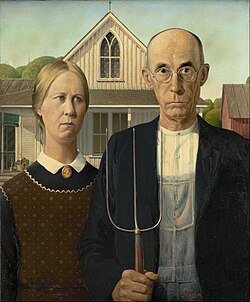- See urban sketching for the making of art on journeys.
Visual arts — including paintings, sculptures, photography, architecture and different handicrafts — make up a major part of the local cultural heritage of virtually any place around the world. Seeing a famous painting or building can easily be one of the highlights of a visit.
Understand
[edit]
While art in some form has existed in every known human society, the word art has no universal accepted definition.
Some well-described art genres are:
- Painting; (the word redirects to this page)
- Sculpture; three-dimensional art, including statues, busts, and reliefs
- Photography: (the word redirects to travel photography, not the art genre)
- Graffiti and murals; painting on buildings, structures and stone
- European art; art by people of European origin from the Middle Ages to the late 19th century
- Modern and contemporary art; trailblazing creations from the late 19th century until today
- Applied art; to items with some practical utility
- Architecture; the design of buildings
- Design tends to follow the periodization and aesthetics of prevalent art styles
- Textiles
- Ceramicware, glassware and lacquerware
Monuments and statues
[edit]A monument can be either a preserved structure or a purpose-built artistic structure made to commemorate a person or an event; they can be shaped as buildings, statues, or abstract sculptures.
Many monuments were erected a long time after the commemorated event, and might tell more about the values of the patron and the artist, than the events and people they depict. Many of them have a historicist design, which might make them look older than they are. Some were erected as propaganda pieces, to consolidate a ruler's cult of personality, or a government's worldview, religion or ideology. While many monuments are iconic to a location, some of them become controversial over time, in a few cases to the extent that they get vandalized, relocated to a less visible place, or dismantled.
Many monuments are combined with memorial place names.
Graves and cemeteries have monuments for deceased individuals, families, and groups of people.
See
[edit]
The number of different arts and art styles in the world is too large to be discussed here, as virtually all cultures and epochs have developed something special. Refer to the historical travel article series and individual destination articles for an overview of art from particular historical epochs, cultures or parts of the world.
Artworks and artifacts are often central part of attractions. For instance religious buildings may include beautiful paintings and other objects.
Art museums and galleries can be found in any major city in the world. Many of them are world famous, like the Louvre in Paris, the Hermitage in St. Petersburg or Prado in Madrid, exhibiting equally famous works. They often exhibit both paintings and sculptures. In addition, historical or archaeological museums are a good place for seeing artifacts; for example, the National Archaeological Museum in Naples has many great ancient Roman paintings, mosaics and sculptures. Countries like Mexico (Aztec, Toltec and Maya), Guatemala (Maya), or Peru (Inca) have museums showcasing their pre-Columbian art and heritage, and even in Latin American countries untouched by the three best known pre-Columbian civilizations, interesting petroglyphs, everyday objects and gems may be on display in major museums.
While the phrases art museum and art gallery can be used interchangeably, an art museum tends to have permanent exhibitions of older art, presented in a historical context. An art gallery usually has temporary exhibitions of contemporary art, in some cases for sale.
Australia has a long history of visual art with evidence of Aboriginal art that dates back over 30,000 years.
Guyana has a wide range of man-made petroglyphs that represent humans and wildlife and can be found in any part of the country.
Buy
[edit]
At popular tourist destinations there may be street artists selling their own art, both paintings and sculptures. Museums may also sell replicas of famous exhibits.
Many destinations are known for some iconic handicraft; from Russian matryoshka dolls to Moroccan brass artwork. Why not go for something that's not just beautiful to look at but something you can use too, like a maté gourd or a traditional piece of clothing?
High-value items are usually sold at auctions: some of these also display the art to the public.
Don't buy
[edit]When your shopping does or may involve antiquities there are two things you need to be careful about. Firstly, the antiquities you've purchased may be fake copies. But it may be worse in the end if you actually have bought antique artwork. It is often illegal to take such items out of the country (at least without a permission from the government) and you will not only have lost your money but the artwork will be confiscated and you will get fined and possibly jailed.
Ivory carvings, polar bear skin rugs and African big game trophies may be banned from import by your own country or excluded from transport by major airlines. It's possible to buy sealskin purses perfectly lawfully in Newfoundland, only to be robbed of these items by US customs upon leaving Canada. Newfoundland seals are not in any way endangered, but laws intended to address legitimate animal ethics issues (like the alarming number of elephants being massacred for their ivory tusks) are inconsistent in both what is being targeted and in enforcement. Antiquities containing ivory, but manufactured before the 1970s (when international treaties first restricted their import or sale) might be perfectly lawful to import - if one has proof of their provenance and applies at a specific border crossing under a specific bureaucratic procedure. Get any of this wrong and those antique bagpipes which have been in the family for generations are forcibly taken from you at the border and likely gone forever.
Respect
[edit]
Photography is often prohibited in art museums, for copyright reasons, to protect the museum's business of selling such photos, and because light from flashes damages the artworks over time and tripods may inconvenience other visitors (or break things if handled carelessly). In some countries, while there are no bans against photographing public buildings and artworks for personal use, there may be restrictions in publishing such photos (for instance uploading them to Wikimedia Commons or social media) unless their copyright has expired, often 70 years since the death of the artist or architect.
